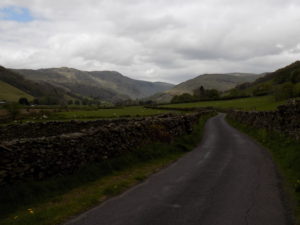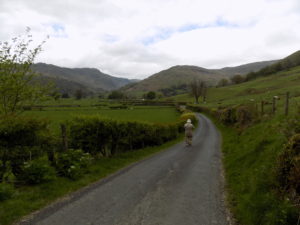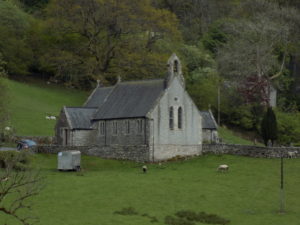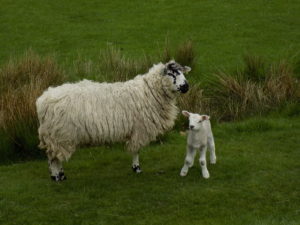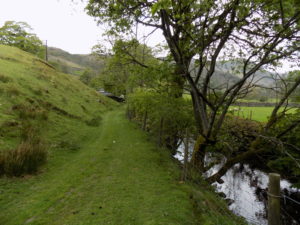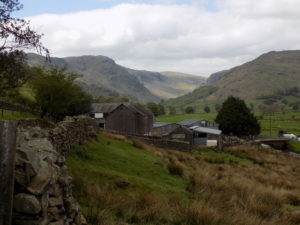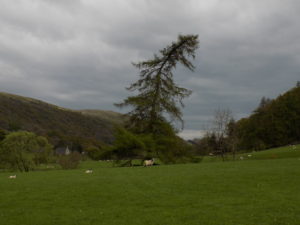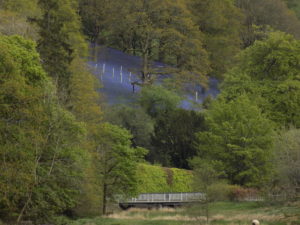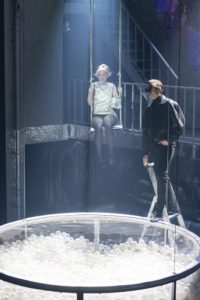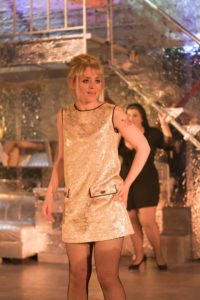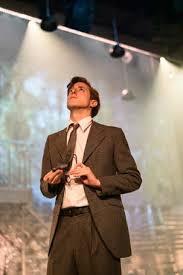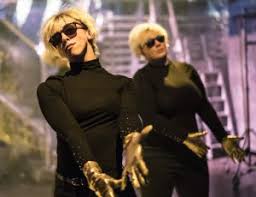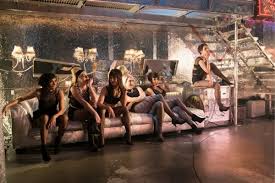Ministry of Flat Walks 25 : Longsleddale
6 May 2019
To follow this walk, open another tab in your browser and input this web address: https://bit.ly/2PNyMw0. The walk is a little under four miles long, with options to make it shorter or longer, and is flat for nearly all the way, with no significant climbs at all.
Longsleddale is a long, remote valley, north to south in the Lakeland fells above Kendal. It is best reached down a narrow road which diverges to the left off the A6 about five miles north of Kendal as you drive towards Shap and Penrith. (If you are still not sure where I mean, change the scale of the map.) Ambitious fell walkers come this way from time to time, as there is a track leading north from the head of the valley over Harter Fell to Haweswater, but otherwise it is very quiet. There is no lake, but the River Sprint, fed by many tributary streams from the fellsides, runs the length of the valley and down to join the River Kent at Burneside, just north of Kendal.
It could have been so different if the Lancaster–Carlisle railway had originally been constructed not by Joseph Locke but by George or Robert Stephenson. The most direct route from north Lancaster would have been along Longsleddale, but would have required the construction of a long tunnel north from the head of the valley towards Penrith. The Stephensons’ philosophy was to avoid steep gradients and construct tunnels where needed; there are seven tunnels on Robert’s route between London and Birmingham. Locke, however, had more faith in the power of his locomotives, and was aware of the cost and delays incurred by tunnelling. So he took the Lancaster–Carlisle railway well to the east, over the summit at Shap, and left Longsleddale in peace.
I had not previously visited Longsleddale, but John came here earlier in the year and reported back that a good flat walk was possible, up and down the valley. Half the walk is along the road, but there is so little traffic that this should not be a problem. Walking up the dale yesterday we were on the road for perhaps three quarters of an hour and were passed by a dozen vehicles (I counted) including a couple of tractors. This was a Bank Holiday weekend too, when well known places in the Lakes become very busy. It may be different in the high season of July and August, but evidently most of the time this is a very quiet spot.
Potential visitors may, perhaps, have been dissuaded by the difficulty of access. The road along the valley from the A6 junction is single track for its full length. It has many blind corners and ungenerous passing places. There are also not many places where you can park. You should certainly not use any of the passing areas for this purpose, not just for good manners’ sake but to preserve your car from being scraped.
There is, however, a small parking area opposite the church, which you can see in the bottom right corner of the map. The church is marked by a plain +. At the same location are a public toilet, basic but clean (blue PC on the map), and a public telephone. The parking area has room for perhaps eight vehicles, at a squeeze. Next to the car park is a large building which I think may be the parish hall, and on its wall is a large map showing points of interest along the valley and explaining the derivation from Old English or Old Norse of the various place names. Did you know, for instance, that “-thwaite,” featured in many Lakeland names, means a clearing? I didn’t.
Park here and walk up the eastern side of the valley along the road. At this time of year the hedgerows are full of flowers and there is a fine view straight ahead to the mountains at the top of the valley. We saw literally hundreds of sheep with their lambs in the fields. John took lots of pictures, striving perhaps for the perfect springtime image, but I will make do with just one of them.
There are very few buildings on the road, but several farm drives lead off to left and right. After about a mile and a half you come to a place (High Barn, on the map) where the road turns right while a track leads straight ahead across the river on a humped stone bridge. There is a wooden bench here facing up the valley if you already feel you need a breather; it would also be a good picnic spot.
You could follow the track across the river here if you wanted a shorter route. Otherwise, continue along the road for another quarter mile or so, over a stream at Stockdale Bridge, to a place where there are signposts to footpaths both left and right. You can go straight on from here, to Sadgill and beyond, but unless you are prepared to tackle some serious hill walking you will then have to retrace your steps to this point. Instead, turn left along a farm track which leads to a bridge over the river. Immediately beyond the bridge, before you reach the buildings at Till’s Hole, turn left along a clearly visible path with the river on your left. You are now heading back down the valley.
This path turns to the right and reaches a gate. Go through the gate and continue straight on along a gravelled driveway until this turns left across a cattle grid. Cross the cattle grid and then turn right, along another driveway and across another grid, towards the buildings at Underhill House. Pass these buildings on your right and continue across a meadow. From here onwards the path is mostly unmarked across pastureland, but you should have no difficulty finding your way: if in any doubt (which should never arise) simply keep going down the western side of the valley, with the river on your left, and you should soon pick up the trail.
You pass more groups of buildings at Well Foot and then at Hollin Root, where there is another opportunity to follow a farm drive down and across the river to rejoin the road. We continued along the path, past here and past Wad’s Howe, where you pass the buildings on your right and then loop back into a yard on your right before turning left again on to the path which is now slightly higher above the valley floor. It was just beyond here that we saw this extraordinary tree, the Leaning Tree of Longsleddale (my name for it) which is, I suppose, evidence of the strength of the wind that sometimes blows down the valley.
After another couple of hundred yards the river bends away to the left, with a path that is not marked on the map following the riverbank. If you continue straight ahead here you will come to a wire fence without a gate and be obliged to climb up the hill to go around another group of buildings and continue the walk further down the valley. So far as I can tell, you could contunue down the valley past Docker Nook to Garnett Bridge (scroll the map to see this continuation) before returning along the road. This would just about double the length of the walk. Instead, John and I followed the riverbank path round the buildings to a gate in the fence. We went through the gate, turned left over what looks like a modern bridge and left again back on to the road; and so back to our starting point.
At some distance before this final crossing we had spotted on the far side of the valley what looked like a purple field. What was it – smoke? netting? flowers? Only when we reached the road could we see clearly. It was a field, or rather a copse, absolutely carpeted with bluebells. Just now there are lots of wild flowers in the hedges and fields, but this was quite extraordinary. I have never seen them in such profusion in one place. Here’s a photograph taken, like all the others in this blog, by John. Thanks to him, once again, for letting me use them.
——————–
Sweet Charity
3 May 2019
Last Wednesday afternoon, Georgina and I went to see a revival of the musical Sweet Charity at the Donmar theatre. Music by Cy Coleman, lyrics by Dorothy Fields, book by Neil Simon. The show was first produced, on Broadway, in 1966 with choreography by the legendary Bob Fosse, and has been revived, in different productions, several times. Georgina had seen it once before, in a 1998 production starring Bonnie Langford; for me it was new. There is also a film adaptation, released in 1969, which was directed and choreographed by Fosse.
This is the show which features the song Big Spender, later made famous in the UK by Shirley Bassey. I didn’t recognise any of the other numbers, though that may be down to my general ignorance of musical theatre. Coleman wrote a number of other musicals, including Barnum and City of Angels, and two great Sinatra hits Witchcraft and The Best is Yet to Come.
I wish I could say I liked Sweet Charity as much as Georgina did. She thought it was great, loved the choreography, laughed at the jokes and generally had a good time. I enjoyed it too, but though the show is cleverly produced and very well performed, it is also rather dated, with a paper-thin story that gets nowhere, and though I admired the music it never really swept me away.
The Donmar has a restricted performance space with very little backstage, so obviously the original Broadway style has had to be adapted to fit the theatre. This is a stripped down production on a largely bare stage, the main props being a set of stepladders, a pair of couches and some Brillo crates, plus a large (3 metre diameter?) transparent tub representing a lake which was lowered from the flies. In keeping with this style the music, though composed in a classic Broadway idiom, has been re-orchestrated for an off-stage nine-piece band.
I liked how this chamber style exposes the bare bones of the music. The musicians are still able to work up a fearsome racket when they want, but there is never any danger of the fuzziness of rhythm and tone that may be produced by a larger group. This treatment works particularly well for Big Spender: a song which Shirley Bassey made into a big raunchy come-on is here much edgier, pinpoint percussion and mocking brass, as the girls of the dance hall where Charity workss taunt their prospective clients. Girl power, indeed.
I did however think the vocal arrangements a little unambitious. The chorus mostly sing in unison; there is very little of the musical counterplay which I have so much enjoyed in the Sondheim musicals Follies (blog of 16 September 2017) and Company (2 January 2019), and in Hadestown (25 January 2019) which I see is now wowing audiences on Broadway. Perhaps I am setting the bar too high, but this feels to me like a missed opportunity.
Georgina and I both really liked Anne-Marie Duff, who stars as the eponymous Charity. Duff is a very talented and versatile actor whom I have seen shine in several earlier productions – as Joan in Saint Joan, Berenice in Racine’s Berenice, and Lady Macbeth in Macbeth. But I haven’t previously seen her in a musical. You couldn’t honestly describe her as a great singer, but it is more than adequate for this role, for which the rough edges in her voice seem in character; and they fit the style of the music. Casting directors for musicals these days seem to prefer actors who can sing (of whom Duff is certainly one) to singers who can act, and it pays off here, because Duff brilliantly portrays Charity’s aspirations and vulnerability.
Duff leads a cast of 15: all the others play multiple roles, notable among them being Arthur Darvill as Charity’s first lover Charlie (who tosses her into the lake in the first scene and makes off with her purse), and then as her fiancé Oscar, whom she first meets in an elevator which gets stuck between floors. That, incidentally, is the show’s funniest scene, evoked almost without props but with the clever use of lighting and an old-fashioned overhead projector. It’s a classic, almost clichéd set-up, but very well done.
None of the other performers really stands out from the rest, but they are all made to work pretty hard. As Georgina said to me after the show, it’s astonishing to think that starting at half past seven they will have to go through it all again. This goes in spades for Duff who sings in seven of the nine musical numbers before the interval and another three out of eight afterwards; she is rarely off stage.
Apart from the lift scene, the production has several other nice touches. That 3-metre transparent tub is filled with lightweight plastic baubles, each the size of a tennis ball, into which Duff can dive and sink without hurting herself: a really clever idea. The atmosphere of New York and various scene changes are evoked by back projections on the rear wall of the set. There is a party scene for which the company dress up in identical black costumes with blond(e) wigs in a mop hairstyle recalling Andy Warhol, who was at the peak of his fame during the 1960s.
And those Brillo crates? In another scene they are unpacked to reveal their contents: a Russian-doll set of otherwise identical boxes stacked one inside another, the smallest being matchbox sized. It’s a good visual joke, though I had to have the symbolism explained to me by one of the reviews that I read afterwards. Apparently they are supposed to represent the frustrations and diminishing rewards of domesticity; or something like that.
I just wish that all this talent and effort and ingenuity had been put into a different show. Charity is a taxi dancer, hired to dance with the customers at a dance hall; each hiring lasts for one dance. I knew none of the social history around this, but there is an informative Wiki article (https://en.wikipedia.org/wiki/Taxi_dancer) if you are interested. Taxi dancers are not necessarily prostitutes, but there is that side to it, which is heavily hinted at in the show. I dare say that in 1966 this was still quite a daring subject for a musical, but what may have been thought shocking and sleazy fifty years ago now seems a bit tame and dated.
Even at the time, though, I am surprised that audiences did not feel a dissonance between Charity’s sad story – by the end of the show she is in much the same boat as she was at the beginning, dumped by a lover, hopes dashed – and the upbeat vigour of most of the music.
She is portrayed as the eternal optimist, and I suppose that’s invigorating in a way, but let’s be clear: no-one dies, and there are laughs along the way, but this is much closer to tragedy than comedy. Charity knows her life is degrading and without prospects, but she fails to escape from it.
Sweet Charity is Josie Rourke’s final production as the Donmar’s artistic director, a post she has held since 2012. During that time she has quietly worked to improve the opportunities for women in theatre, without making it a great public cause, or distorting her programming to do so. It’s been suggested that she chose this for her final show as a paean for female resilience and solidarity. If so, it’s an odd choice. Charity’s greatest ambition is for marriage and domesticity, entirely understandable in her circumstances but well short of what modern women aspire to. Her trusting optimism does her as much harm as good. Certainly the girls at the dance hall are mutually supportive, but that’s not the abiding thought you take away from the theatre.


